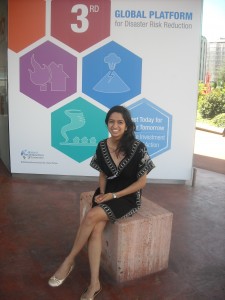Salina Dharamsi, a World Vision Youth Ambassador, recently participated in a couple important events with the United Nations. We caught up with her and asked her to reflect on her experiences.
1. Tell us about your recent activities with World Vision International.
In February of 2011 I was invited to participate in a multi-stakeholder debate at the United Nations in New York. The timely discussion, titled “Taking Collective Action in Disaster Risk Reduction for Good Governance – Investing in Our Children’s Future,” focused on disaster risk reduction and involved delegates from the UNDP, World Vision International, Save the Children and Unicef. As one of only two youth representatives at the talk, I advocated strongly for increased youth participation in disaster risk reduction activities and collaborated with leaders and believers in DRR to help develop tangible ways to increase youth participation in all areas of DRR related work.
In May of 2011, I was blessed with the opportunity to serve as a youth facilitator for the Global Platform for Disaster Risk Reduction in Geneva, Switzerland. Managed by the UN International Strategy for Disaster Reduction, the Third Session of the Global Platform brought together over 2,000 policy makers and practitioners from government, international organizations, NGOs, academia, and the private sector. Together we assessed and shared information and ultimately set new directions for disaster risk reduction work.
2. Tell us more about Disaster Risk Reduction as it relates to Climate Change.
Disasters (such as hurricanes, cyclones and flooding) are predicted to occur more often and with greater intensity due to climate change. It’s estimated that every year 175 million children will be affected by sudden climate-related disasters; without increased awareness and commitment from the global community lives of people just like us will tragically be lost.
3. What was your main message at the New York City event?
My main message at the New York City event was shaped by numerous conversations I had with young people before I left for the UN. The common thread between all the discussions I had was that the average Canadian youth feels left out of disaster risk reduction activities. During my address I emphasized three needs that, if addressed, will allow for greater youth participation in DRR related activities:
1. The need for age appropriate DRR information.
2. The need for greater emphasis on two-way communication channels where young people can engage with experts and experts in turn can engage with young people.
3. The need for leaders and believers in DRR to find specific, tangible, realistic and engaging niches in which youth can have substantial input and impact.
In essence, I focused on how the huge global issue of DRR needs to be broken down into tangible steps to engage the 6.5 million youth in Canada (and other young people globally) who are willing, eager and ready to get involved in DRR related decisions that will ultimately shape their futures.
4. Tell us about some of the youth you met in both New York and Geneva.
Through my participation in both of these events, I had the opportunity to meet several inspiring young leaders from disaster-afflicted areas of Kenya and the Philippines. Representing their communities, these young people shared how they have been directly involved in equipping their communities from drought and typhoons.
5. What did you learn through the experience?
The multi-stakeholder debate and Global Platform reinforced my passion for development and advocacy work and opened my eyes to the progress that can be obtained when passionate leaders from a variety of professional backgrounds come together.
6. How can Canadian youth be involved on this issue?
This is a really exciting time for young people to be involved in DRR related activities. With the recent development of the Children’s Charter for Disaster Risk Reduction and youth participation at high-profile events, the opportunities for youth to be powerful vessels of faith and hope, and protect nations in need are becoming more and more available. Don’t hesitate to research online or reach out to an organization you are familiar with for more information on how you too can be a part of DRR!

Recent Comments